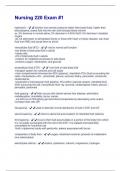Nursing 220 Exam #1
hypertonic - ✔️✔️solution has osmotic pressure higher than body fluids, higher than
blood plasma; draws fluid into the vein and increase blood volume
ex. 5% dextrose in normal saline, 5% dextrose in 0.45% NaCl, 5% dextrose in lactated
ringers
-do not administer to dehydrated clients or those with heart or kidney disease, can draw
fluid from RBC and cause them to shrink
intracellular fluid (IFC) - ✔️✔️-vital to normal cell function
-two thirds of total body fluid in adults
-inside cells
-2/3 of total body fluid in adults
-medium for metabolic processes to take place
-contains oxygen, electrolytes, and glucose
extracellular fluid (FCF) - ✔️✔️-one third of total body fluid
-transport system for nutrients and cell waste
-main compartments-intravascular=20% (plasma), interstitial=75% (fluid surrounding the
cells), transcellular=<5% - pericardial, pleural, synovial, biliary, pancreatic, intraocular,
cerebrospinal
-comprised of intravascular fluid (plasma, IVC)-within vascular system, interstitial fluid
(ISF)-surrounds the cell, transcellular fluid- eg. synovial, cerebrospinal, biliary, pleural, -
pericadial, peritoneal
fluid spacing - ✔️✔️often occurs with clients-severe liver disease, alcoholism,
malabsorption, immobility, burns, cancer
- s/s-shift out of IVS-kidney get less blood-compensate by decreasing urine output,
increase heart rate, BP,
fist spacing - ✔️✔️used to describe normal distribution of fluid in ECF and ICF
second spacing - ✔️✔️refers to abnormal accumulation of interstitial fluid (edema)
third spacing - ✔️✔️occurs when fluid accumulates in a portion of the body from which
it is not easily exchanged with the rest of the ECF, it is trapped and essentially
unavailable for functional use
-fluid in abdominal cavity with peritonitis, edema associated with burns
composition of body fluid - ✔️✔️oxygen, dissolved nutrients, products of metabolism,
ions (electrolytes)
electrolytes-cations - ✔️✔️sodium, potassium, calcium, magnesium, hydrogen
, electrolytes-anions - ✔️✔️chloride, bicarbonate (HCO3), phosphate (PO4)
solutes - ✔️✔️substances dissolved in a liquid
ex. oxygen, CO2, glucose, urea, amino acids, proteins
solvents - ✔️✔️components of a solution that can dissolve a solute
ex. water
crystalloids - ✔️✔️salts that dissolve readily
colloids - ✔️✔️substances that do not readily dissolve
ex. large protein molecules
water - ✔️✔️-amount affected by age, sex, and body fat
-function: medium for metabolic reactions within cells, transport for nutrients, waste
products, and other substances, lubricant, insulator and shock absorber, means of
regulating and maintaining body temperature
-60% of an average adult's weight
-70-80% of infant's body weight
-men have a higher percentage because they have more muscle, women have a lower
muscle mass and greater percentage of fat tissue(fat cells contain no water)
osmosis - ✔️✔️water moves toward the higher concentration to equalize the
concentration
osmolality (tonicity) - ✔️✔️concentration of solutes in body fluids
osmotic pressure - ✔️✔️power of a solution to draw water across a semi-permeable
membrane to equalize concentration of solutions
colloid osmotic pressure/oncotic pressure - ✔️✔️osmotic draw by plasma proteins
which pulls water from the interstitial space into the vascular compartments
isotonic - ✔️✔️solution has the same osmotic pressure as body fluids, same as blood
plasma; often used to restore blood volume
ex. 0.9% NaCl (NSS), lactated ringers, 5% dextrose in water
hypotonic - ✔️✔️solution has osmotic pressure less than body fluids, lower than blood
plasma; draws fluid from the blood into body tissue to hydrate cells
ex. 0.45% NaCl, 0.33% NaCl
-can cause fluid to be drawn into RBC, cause them to swell and rupture (hemolysis)




